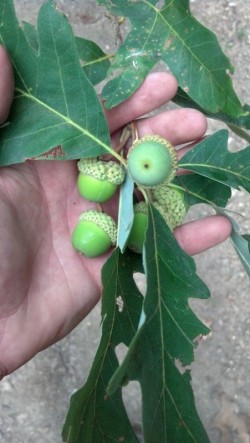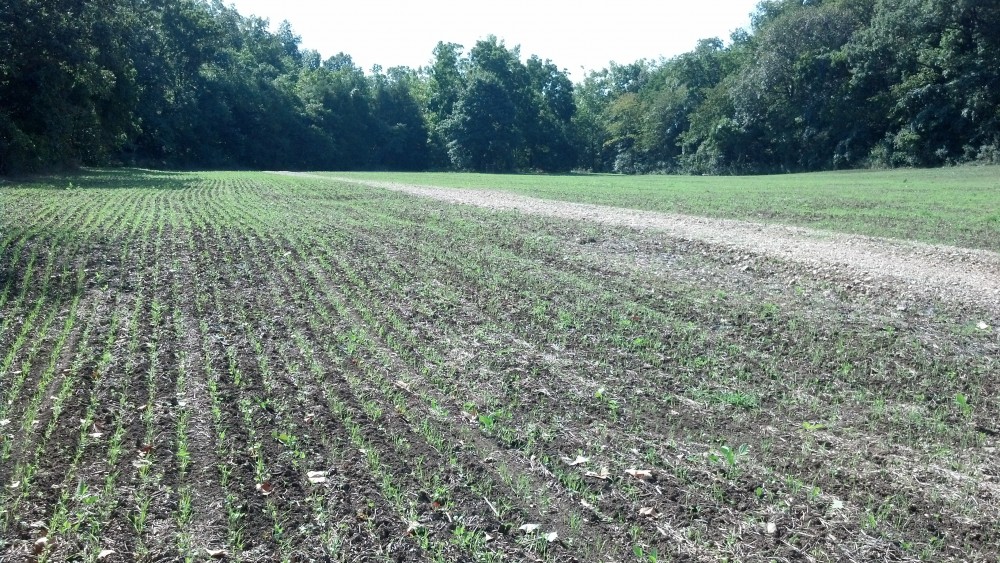Category: Bow Hunting
Bow Hunting: Early Season Plan of Attack
It’s September 14 and we’re only one day away from the opener of Missouri archery season! SAWEEEET!!! The wait is almost over, and all the preseason preparation is about to be put to the test. There are the months of shooting your bow, hanging and trimming treestands, washing your clothing, planting food plots and possibly looking through thousands of Reconyx images, all for the hopes of tagging a trophy buck! Now that the season opener is knocking at our door, I’m sure we’re all drawing out a game plan. If you’re in an area that has a great acorn crop you’re probably planning on heading into your best oak stand. Those of you in areas dominated by crop fields, you’ve probably spent the summer glassing bucks in velvet and will find yourself sitting on the edge of the field somewhere with high expectations. As of a week ago Grant and I were planning on being in the woods listening to acorns fall, but with recent scouting our plan has changed!
Throughout the summer we’ve located several big red and black oak trees with lots of acorns on them. As the acorns have matured and began to fall we’re noticing more and more uneaten acorns lying on the ground. While working this morning spreading some Deer Trac, I noticed a lot of fresh browse on young soybeans and wheat, and a very large amount of tracks around. This certainly fits the definition for M.R.I. (Most Recent Information) so Grant and I will find ourselves staring at a nice Eagle Seed Buck Monster Wheat food plot on Saturday afternoon hoping for the chance at a hit list buck!
Good luck to all my fellow bow hunters who will be hitting the woods this weekend and in weeks to come! Be safe and always have fun!
Dreaming of Giant Whitetails together,
Adam
Patterning A Mature Buck
I grew up rabbit hunting. It was the game of choice as there wasn’t a deer season in the county where I was raised. One of my favorite pastimes was tracking or back tracking rabbits in the snow. I probably learned more about rabbits and rabbit hunting by back tracking rabbits in the snow than I did from anything else with the exception of invaluable lessons from my grandfather and father (they were incredible rabbit hunters). In hindsight, those lessons were of huge value to me as a deer biologist and hunter. I learned that critters need food, cover, and water and will use the path of least resistance to move from one to another AS LONG AS THEY DON’T FEEL THREATENED ALONG THOSE PATHS.
The same is true for mature bucks. They need food, cover, and water on a regular basis and will move between these resources along the path of least resistance as long as they don’t feel threatened. One of my hunting tactics is to determine if there are mature bucks in the area by using Reconyx cameras and then use aerial photos to locate the likely sources of food, cover, and water close to the camera that photographed the buck. Notice that I didn’t say I moved the camera to monitor the sources of food, cover, and water. One of my keys to success is being very aware of the bold words in the previous paragraph – AS LONG AS THEY DON’T FEEL THREATENED ALONG THOSE PATHS.
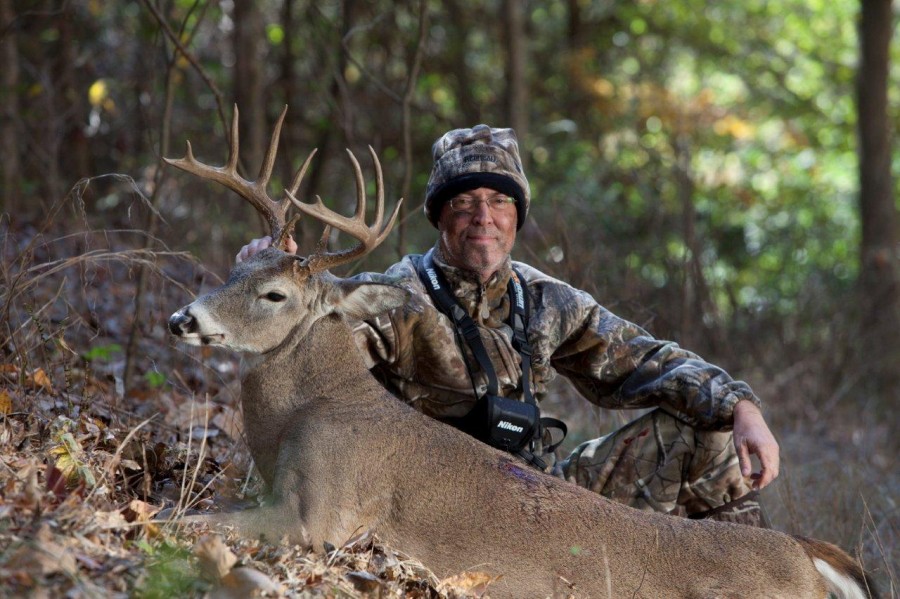
Most of my neighbors hunt and deer are constantly being alerted during the season in my neighborhood. I know deer will range off my property. However, I want to encourage them to spend as much time on my property during daylight hours as possible. That’s one reason why I created sanctuaries! Deer, even during the rut, will likely spend most of the day resting in thick cover. If I can protect bucks during the day, they will have a good chance of surviving to maturity. In addition, if mature bucks are conditioned to finding safety in the same area (sanctuaries), then it’s easier to pattern them.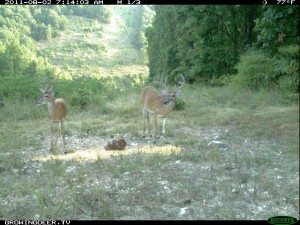
I used this strategy last Friday to kill a buck I had named Clean 12. It was a great hunt as I watched the buck for more than 10 minutes including watching him make a scrape, thrash some limbs with his antlers, and vocalize a snort wheeze. I ended up shooting Clean 12 at three yards! It was a thrilling hunt!! However, what made this encounter with Clean 12 work was simply applying the strategy outlined above.
I had obtained several Reconyx images of Clean 12 during the late summer. I placed some Reconyx cameras in open areas such as Trophy Rock stations and food plots to get a feel for his range and travel patterns.
I knew I wouldn’t likely hunt at any of those camera stations 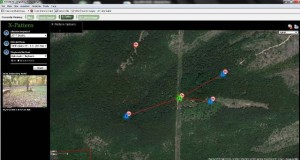 because they were in open areas. Mature bucks would rarely visit them during daylight once season opened. I then used my knowledge of the closest locations for food (used mainly at night by mature bucks this time of year), water (several springs and seeps in the area so no way to predict which source he might use), and cover.
because they were in open areas. Mature bucks would rarely visit them during daylight once season opened. I then used my knowledge of the closest locations for food (used mainly at night by mature bucks this time of year), water (several springs and seeps in the area so no way to predict which source he might use), and cover.
Years ago I had created a sanctuary at the east end of the area where I had images of Clean 12. It seemed the obvious bedding area for Clean 12 . It was the most limiting of three needs a deer has daily (food, water, and cover) in the portion of his range I had confirmed. In addition, I could approach from the east and not enter the area where I had patterned him mainly at night. A northwest, west, or southwest wind would be perfect for the area between where I knew Clean 12 was using and the sanctuary. This area is a de facto transition zone. Deer shouldn’t feel threatened moving into the sanctuary so the site I picked to hang my Muddy stands was the path of least resistance. Finally, the sanctuary was lower in elevation than the ridge where I had determined Clean 12 was using at night and the thermals would be pulling scent downhill (east) and away from where I predicted Clean 12 would be coming from toward the sanctuary.
With my plan in place, Adam (my cameraman) and I were able to approach our stands without alerting deer anywhere to the west of us. About 9 am, I spotted a buck 70 yards away moving toward the bedding area. The habitat work, placement of the Reconyx cameras, and Muddy stands had paid off. You can see the events that occurred when Clean 12 closed the last 70 yards on GDTV 101.
Growing (and hunting) Deer together,
Grant
Deer Hunting and Scent Control: How Good is a Deer’s Nose?
Most hunters know that deer have a great sense of smell. However, it is very difficult for researchers to determine just how good a deer’s sense of smell is. We can’t put samples in front of a deer and ask them if they can detect this odor or chemical. However, earlier this week I indirectly witnessed an example of how well deer can smell.
I shot a doe in the liver with my bow. I reviewed the footage on a high quality HD camera (we were filming for GrowingDeer.tv). I knew the hit would be fatal, but the trailing job would be a bit longer than a deer shot in both lungs. We waited an hour then took up the trail, which was easy to follow for the first 100 yards. The doe then traveled through a grove of cedars and blood doesn’t show up very well on cedar needles. In Missouri, all possible means to recover a deer must be used before using a dog to trail. I felt we were at that point so I called the local conservation officer and obtained permission to use Crystal, our 18 month old lab. Tracy, my wife, has been training Crystal to follow blood trails.
Crystal was a bit confused at first given all of my scent, but eventually she picked up the trail. She trailed the doe through the cedars, across a food plot, across a dry creek, through chest high weeds along the creek, down a gravel road for 100 yards, then 50 yards into a thick bedding area. I was thrilled to see the doe piled up and gave Crystal several treats and plenty of “good girl” comments!!
Besides being thrilled to recover the doe, I was once again shown how well deer can smell. It’s generally assumed that prey species (deer included) have as good, if not a better, sense of smell than predator species (Crystal included). This is one reason prey species are able to survive.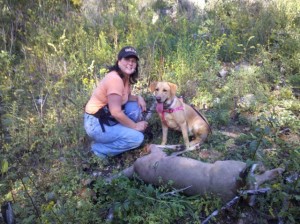
Several vehicles had driven the gravel road between when I shot and when Crystal trailed the doe down the gravel road. The humidity was low that day and because gravel is not porous it is not a good surface to hold scent. The gravel had been covered by vehicle exhaust, dripping oil, etc. Neither I, nor the folks helping, saw one drop of blood on the gravel road. Simply stated, Crystal was able to trail the deer in horrible conditions.
I share this event to illustrate how good a deer’s sense of smell is. It’s incredible! Based on this and gads of other similar observations, my hunting strategy has changed over the years to include reducing as much scent from my gear and myself as much as possible.
I start with a shower. I then dry myself with a clean towel that’s been laundered in scent free soap. My hunting clothes have been laundered with scent free soap also and stored in a barn that doesn’t have gas, etc., stored close by. I take my hunting clothes and gear to the field in clean tubs and change into them beside my truck just before I walk to my stand. Yes, it can be wicked cold changing in the field during the late season. I have a pair of boots I only use when I hunt. I never wear them inside my truck, let alone to go shopping, get gas, etc. I use the Dead Down Wind system because it is based on enzymes that destroy chemicals and bacteria that are the source of odors. Most scent control systems are only a bactericide – just one source of odors.
The effort involved to take these steps is worth it to me as I frequently watch deer cross the path I use to access my stand. In fact, I watched multiple deer cross the path the cameraman and I used to access my stand this past Wednesday, when I harvested two does. Multiple deer fed 270 degrees around the stand without giving any indication they smelled Adam (the cameraman), me, or our gear. It was a beautiful morning in the woods watching deer and bringing home some venison. I believe it occurred because Adam and I use a simple, but effective scent reduction system.
A deer’s sense of smell is amazing. However, by reducing the scent on me and my gear as much as possible by using a complete system, I have shown that I can keep from alerting deer to my presence. This is critical in the humid, swirling wind conditions where I live and hunt. During bow season, controlling my scent enough that deer may approach 10 yards closer can lead to more opportunities to draw back my bow.
I like watching Crystal work, but would rather watch her trail someone else’s deer. I’ll keep using my system and let my buddies know Crystal is available if they make a bad hit.
Growing Deer together,
Grant
Fight Target Panic with Bow Practice
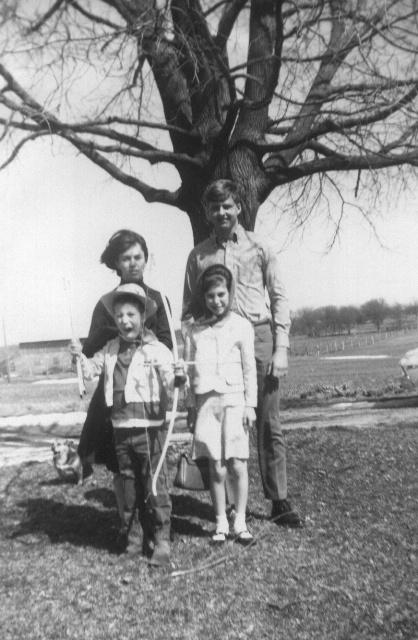 I’ve shot a bow since early childhood. Even with that level of experience (I’m now 50), I still go through seasons of struggling with shooting accurately. Archery is a very mental sport and no one stays on top of their game every day (or season). In my last blog, bow practice, I discussed the “perfect practice makes perfect” principle as applied to shooting a bow. This week, I’d like to share an archery practice technique called blind bale. It is really a different form of “perfect practice makes perfect.” It is simply practicing with your bow at a target that is only three feet or so down range. In addition, the shooter has his eyes closed throughout the shot. This is done so the shooter can totally concentrate on form and not aiming at a spot.
I’ve shot a bow since early childhood. Even with that level of experience (I’m now 50), I still go through seasons of struggling with shooting accurately. Archery is a very mental sport and no one stays on top of their game every day (or season). In my last blog, bow practice, I discussed the “perfect practice makes perfect” principle as applied to shooting a bow. This week, I’d like to share an archery practice technique called blind bale. It is really a different form of “perfect practice makes perfect.” It is simply practicing with your bow at a target that is only three feet or so down range. In addition, the shooter has his eyes closed throughout the shot. This is done so the shooter can totally concentrate on form and not aiming at a spot.
I started this technique while suffering through a bad case of target panic. When my sight pen would come close to the spot I was aiming, I wouldn’t be able to trigger a release with my eyes open. If you’ve never experienced target panic, you can’t understand, and if you have, you share my grief! A friend of mine, CJ Davis, shared the blind bale technique with me. I thought it sounded silly and continued flinging arrows and flinching. Most shots failed to hit close to where I was aiming.
Out of desperation, I tried the blind bale technique. I shot at a target placed a few feet in front of me for a week. I shot for a week without looking at a spot. I simply shut my eyes and totally focused on my shooting form. During week two, I took 10 shots blind bale and then shot at a pie plate at 10 yards with no markings on it – just a white 9” target. I was amazed at the end of two weeks how well I shot. I was able to group as good as any time during my archery career.
Since them, I usually begin each archery practice session by shooting 10 or so shots using the bind bale technique. At times, I’ve forgotten the lessons I’ve learned and simply began flinging arrows. The size of my groups increase and I remember the huge advantages of reinforcing correct form and starting each practice session with the blind bale technique.
This technique will not benefit everyone as they may have a different problem such as shooting a bow that’s draw weight or length is not appropriate for them. However, if your shooting problems are not the result of equipment that is not tuned or equipment that is mismatched to you, then incorporating the blind bale technique into your practice will probably result in tighter groups at all distances.
Growing Deer together,
Grant
Bow Practice
I really enjoy shooting a bow. However, like most hunters I’m busy with family, work, etc, and my time to simply fling arrows is limited. Therefore I need to make my practice time as effective as possible. Over the years, I’ve learned some lessons that have definitively helped me be a better archer. These include the principle that “perfect practice makes perfect.”
Several years ago I practiced and hunted exclusively with a Black Widow recurve. In fact, the best buck I’ve harvested with a bow was shot with one of my Black Widows! I had shot a recurve on and off since childhood. However, in hindsight, I realized I had simply been flinging arrows. I attended an instinctive shooting clinic hosted by Black Widow and the instructor, Fred Asbell, taught that “perfect practice makes perfect.”
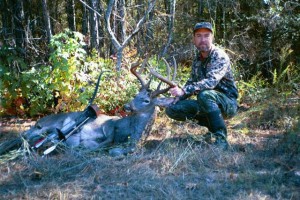 The jest of this principle is that we all learn by memorization – either mental or physical (muscle memory). So, if we simply fling arrows, we may not come to a complete draw, shut our eyes, release improperly, etc. We will be much better archers if we focus on our technique on each shot. If we do that, our muscles will remember the form and it will automatically occur when we don’t have time to go over our mental check list – like when aiming at a mature buck.
The jest of this principle is that we all learn by memorization – either mental or physical (muscle memory). So, if we simply fling arrows, we may not come to a complete draw, shut our eyes, release improperly, etc. We will be much better archers if we focus on our technique on each shot. If we do that, our muscles will remember the form and it will automatically occur when we don’t have time to go over our mental check list – like when aiming at a mature buck.
Since then, I’ve tried to slow down and make each shot count. I’m not a perfect archer, but I’m probably as good as my schedule allows. If you have limited time to shoot your bow, try incorporating the “perfect practice makes perfect” principle into your practice sessions. You will probably fling a few less arrows, but more will be where you are aiming – especially when the target has a lot of bone on its head.
In my next blog, I’ll share another technique that has helped me be a much better shot with a bow. In fact, it helped me resolve some problems I had with target panic.
Growing Deer together,
Grant
Creating Hidey Holes
Brad, Hunter, Nathan, and I scouted some areas for new Hidey Hole food plots today. Hidey Hole plots are small plots that are usually less than an 1/8th of an acre in size. I usually create them by using hand tools – no tractors or mechanical equipment. The ideal location for a Hidey Hole plot is an area where:
- Deer frequent
- Hunters can access without being detected by deer
- Wind direction usually remains constant (like a ridge top)
- It helps if no large trees need to be removed
We like to locate these areas this time of year to limit disturbance to the deer herd closer to season. In addition, we begin killing brush, etc., now with a herbicide so when we remove saplings they don’t sprout back. We kill any grass or broadleaf weeds with a herbicide so they will dry up before planting season.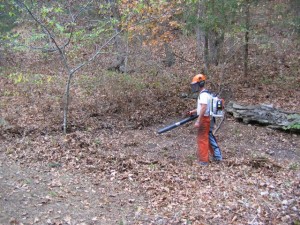
Just before planting the forage crop, I add ample fertilizer to help the forage crop grow rapidly and taste palatable to deer. For example, one 50 pound bag of 19 19 19 fertilizer applied to 1/8th acre is equivalent to applying 76 pounds of N, P, and K (400 pounds of 19 19 19) per acre. That’s usually enough to get a forage crop like wheat up and tasty for a month or two of great forage production. I plant the crop roughly three weeks before I anticipate hunting or the first frost. I also hang my Muddy stands and secure my Muddy SafeLine well before hunting season.
I try to avoid the area from when I plant until I hunt to allow deer to become conditioned to feeding in the area without being alert to two-legged predators. This is a critical step in creating a successful Hidey Hole food plot. In addition, I only hunt this location when the wind direction is appropriate. I don’t waste the effort spent creating the hotspot by allowing the local deer to associate the spot with human (predator) activity.
This is a great technique to see and harvest mature bucks that can be used on properties from ten to 1,000 acres. Hidey Hole food plots are not designed to increase the quantity of nutritious forage in an area, but to allow hunters to observe and harvest mature bucks at close range by providing high quality forage with minimal equipment and expense. Hidey Holes are a great tool to harvest mature bucks.
Growing Deer together,
Grant



